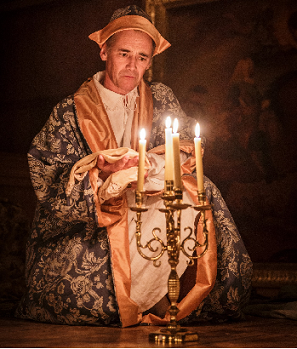
Having had a lovely experience with onstage seating last week at the opening night of Close to You – Bacharach Reimagined, I was REALLY excited to have onstage seating again, this time for Farinelli and the King, who wouldn’t want to see the marvellous acting talents of Mark Rylance in this 5 star play, up close and personal?

In advance I knew that the seats were not this time plush sofas but hard church-like pews, I also knew by looking at the seating plan further that we were sat in the stalls at the back of the stage so suspected that much of the play we would be looking at the backs of the actors, but I was undeterred.
I knew the routine by now, no photos on stage, no drinks onstage, be seated early and once in place you may not leave, and under no account do not cross the stage. All pretty obvious really. We keenly met the usher at the alloted (early) time and were taken backstage.
Surprisingly we were then led up a long flight of stairs and taken to our pew (which to be fair had quite comfy cushions on it) which were with the orchestra above the stage, the orchestra being 18th century string instruments with the centrepiece a beautiful harpsichord played by the Musical Director (and very friendly) Robert Howarth.
I sat in the end seat E1 and immediately saw what my problem was going to be. To see the stage you had to not only lean over the balcony for a bird’s eye view of the actors directly below, but also by sitting at the end you had to twist your neck to the side at a perculiarly odd angle to see the stage.
The play starts….Rylance as the King Philippe V of Spain is wheeled in on his bed and we had lovely view of the top of his hat. But as the play went on, the wonderfully ornate candleabras (with real candles) were lowered toward the stage for the remainder of the play obstructing our view further.
Philippe V is troubled, suffering from depression and not sleeping. His doting wife Isabella Farnese commissions famous castrato Carlo Farinelli to come to Spain and sing for him. Music is the best therapy and although the King ultimately does not recover he is helped enormously by Farinelli’s singing. Farinelli abandons his successful career and serves the King for the rest his life
Farinelli is cleverly played by two men – the actor Sam Crane and the singer, a role that is alternated by three accomplished artists, of which I saw Rupert Enticknap, a wise move as you’d be hard pressed to find an actor who can sing arias as they were intended to be heard. The ones used in this play were songs reputed to be amongst those sung by the actual Farinelli. Fortunately the arias were not heard by me, sitting so close to the orchestra Enticknap’s vocals were drowned out.
The story written by Rylance’s wife Claire van Kampen was lovely, focusing on the relationship between these two great men who had both had unwillingly had greatness thrust upon them was moving and had a great amount of humour. The story flowed very well and even at times when it was too uncomfortable to lean over to see, I know for a fact that it would work well as a radio play.
So despite the candles drying the air giving me a tickle in the throat that was hard to repress, despite not being able to see particlarly when a backdrop was lowered, presumably changing the scenery, despite not being able to to hear arias that were a central focal point of the writing, despite not being able to see anyone’s entrances or exits and being able to apprecate the ornate set that we glimpsed during the interval, it was a superb show with outstanding performances.
Mark Rylance openly advocates cheaper seating in order to make theatres accessible for all. Farinelli and the King prices range from £10 – £90 with over 50 seats per performance being sold at £15. My seat cost £30 and I therefore I strongly suggest you save money and get a much better view, if you can get tickets at all.
Note: Onstage seating:
Rows A and B would be superb, they are at stage level, side on.
Rows C and D are high, therefore looking down at the stage, however they are to the side of the stage therefore although you would miss part of the performance directly below, you would still see much of the play (C a lot better than D)
Row E avoid – on the ticket it does not state restricted view but much of the production sadly was unseen by me.
Reviewer: A disgruntled and rather disppointed Sammi O’Neill
PS. A special thanks to Mark Rylance for looking up at us at the curtain call – it was nice to see actually see a face!
Performance: Probably ☆☆☆☆
Seat: ☆